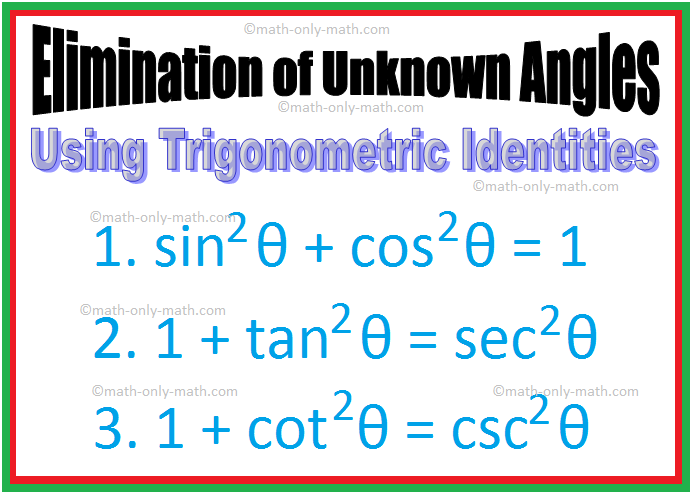Subscribe to our ▶️ YouTube channel 🔴 for the latest videos, updates, and tips.
Elimination of Unknown Angles
Problems on elimination of unknown angles using trigonometric identities.
1. If x = tan θ + sin θ and y = tan θ - sin θ, prove that x2 – y2 = 4\(\sqrt{xy}\).
Solution:
Given that
x = tan θ + sin θ ……………………. (i)
and
y = tan θ - sin θ ……………………. (ii)
Adding (i) and (ii), we get
x + y = 2 tan θ ……………………. (iii)
⟹ tan θ = \(\frac{x + y}{2}\) ……………………. (iv)
Subtracting (ii) from (i), we get,
x - y = 2 sin θ ……………………. (v)
Now, dividing (iii) by (v) we get,
\(\frac{x + y}{x - y}\) = \(\frac{2 tan θ}{2 sin θ}\)
= \(\frac{tan θ}{sin θ}\)
= \(\frac{\frac{sin θ}{cos θ}}{sin θ}\)
= \(\frac{sin θ}{cos θ}\) ∙ \(\frac{1}{sin θ}\)
= \(\frac{1}{cos θ}\)
= sec θ
Therefore, sec θ = \(\frac{x + y}{x - y}\) ……………………. (vi)
We know that the Pythagorean identity, sec\(^{2}\) θ - tan\(^{2}\) θ = 1.
Now from (iv) and (vi) we get,
\((\frac{x + y}{x - y})^{2}\) - \((\frac{x + y}{2})^{2}\) = 1
Taking common (x + y)\(^{2}\) we get,
⟹ (x + y)\(^{2}\) ∙ {\(\frac{1}{(x - y)^{2}} - \frac{1}{4}\)} = 1
⟹ (x + y)\(^{2}\) ∙ \(\frac{4 – (x – y)^{2}}{4(x – y)^{2}}\)= 1
⟹ (x + y)\(^{2}\) ∙ {4 – (x – y)\(^{2}\)} = 4(x – y)\(^{2}\)
⟹ 4(x + y)\(^{2}\) - (x + y)\(^{2}\) ∙ (x – y)\(^{2}\) = 4(x – y)\(^{2}\)
⟹ 4(x + y)\(^{2}\) - 4(x – y)\(^{2}\) = (x + y)\(^{2}\) ∙ (x – y)\(^{2}\)
⟹ 4(x\(^{2}\) + y\(^{2}\) + 2xy - x\(^{2}\) - y\(^{2}\) + 2xy) = \((x^{2} + y^{2})^{2}\)
⟹ 4 ∙ 4xy = \((x^{2} + y^{2})^{2}\)
⟹ 16xy = \((x^{2} + y^{2})^{2}\)
⟹ 4\(\sqrt{xy}\) = \(x^{2} + y^{2}\)
Therefore, \(x^{2} + y^{2}\) = 4\(\sqrt{xy}\). (Proved)
2. If a = r cos θ ∙ sin β, b = r cos θ ∙ cos β and c = r sin θ then prove that a\(^{2}\) + b\(^{2}\) + c\(^{2}\) = r\(^{2}\).
Solution:
a\(^{2}\) + b\(^{2}\) + c\(^{2}\) = r\(^{2}\) cos\(^{2}\) θ ∙ sin\(^{2}\) β + r\(^{2}\) cos\(^{2}\) θ ∙ cos\(^{2}\) β + r\(^{2}\) sin\(^{2}\) θ
= r\(^{2}\) cos\(^{2}\) θ(sin\(^{2}\) β + cos\(^{2}\) β) + r\(^{2}\) sin\(^{2}\) θ
= r\(^{2}\) cos\(^{2}\) θ ∙ (1) + r\(^{2}\) sin\(^{2}\) θ, [since We know that the Pythagorean identity, sin\(^{2}\) θ + cos\(^{2}\) θ = 1.]
= r\(^{2}\) cos\(^{2}\) θ + r\(^{2}\) sin\(^{2}\) θ
= r\(^{2}\) (cos\(^{2}\) θ + sin\(^{2}\) θ)
= r\(^{2}\) ∙ (1), [since, sin\(^{2}\) θ + cos\(^{2}\) θ = 1]
= r\(^{2}\)
Therefore, a\(^{2}\) + b\(^{2}\) + c\(^{2}\) = r\(^{2}\). (proved)
From Elimination of Unknown Angles to HOME PAGE
Didn't find what you were looking for? Or want to know more information about Math Only Math. Use this Google Search to find what you need.



New! Comments
Have your say about what you just read! Leave me a comment in the box below. Ask a Question or Answer a Question.